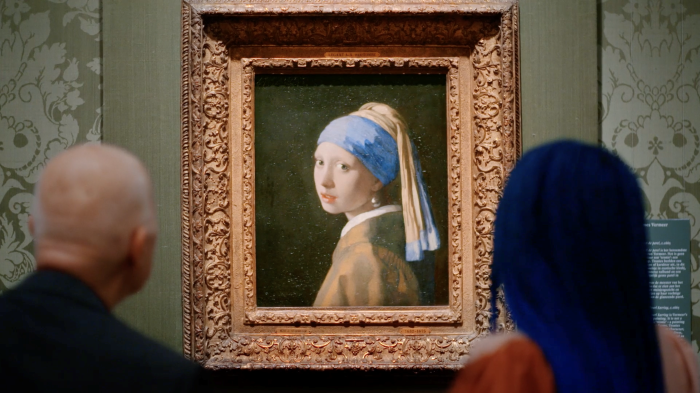“What makes a Vermeer a Vermeer?” is the question that opens Suzanne Raes’s meticulously observed and detailed documentary, which examines the enigmatic painter on the eve of the largest Vermeer exhibition ever mounted. (Completely sold out, it’s running through June 4 at Amsterdam’s Rijksmuseum.)
Johannes Vermeer (1632–1675), who was born and died in the Dutch city of Delft, left behind a widow and 11 children, along with 37 or so paintings that experts consider to be from his brush, including such beloved works as The Girl with the Pearl Earring and The Lacemaker. That’s about all we know, because Vermeer left behind no diaries, no letters, no self-portraits—he’s the art world’s parallel to William Shakespeare, who similarly left behind a small paper trail beyond his 37 or so plays. As Gregor J. M. Weber, the curator of the Rijksmuseum exhibit, says, “All we have are the paintings.”
Those artworks have become among the most valuable in art, nearly all of them in museums and galleries. Unlike many other master painters, Vermeer rarely worked on a large scale. He painted mainly intimate domestic scenes, nearly all on small canvases. With such a tiny oeuvre, it’s difficult to mount a huge Vermeer exhibit—the last one was in 1995–’96, when 21 paintings were shown at the Mauritshuis in The Hague and the National Gallery of Art in Washington, DC (which is where I saw it). For this exhibition, curators Weber and Pieter Roelofs are hoping to acquire as many extent Vermeers as possible, and Raes follows them through Europe and the United States as they visit other museums and make their case.
The Frick Collection in Manhattan lends all three of its Vermeer paintings, but when Roelofs calls on the Metropolitan Museum of Art—which counts among its vast holdings five of the revered artist’s works—he is told that one of the paintings is too fragile to travel and two others cannot be lent due to the stipulations of their original bequests, so only two can be part of the exhibition.
The curators hit other walls too. Weber travels to a small German museum to secure its lone Vermeer painting, but he is told that the region’s students will be taking their final art exam based on that painting, so it cannot be moved. More ominously, one of the Vermeers at the National Galley, Girl with a Flute, has, after extensive analysis, been downgraded to a mere “Studio of Vermeer,” which, in this rarefied world, is the kiss of death. The Rijksmuseum’s solution? Upgrade it back as a Vermeer for the exhibit, which allows the curators to evade dealing with the thorny question of whether the artist possibly had a studio or school of followers, for which very little evidence exists, if any. Both the American and Dutch experts are cordial about the disagreement. When it’s announced that the painting will be shown in Amsterdam as an authenticated Vermeer and not, as in Washington, from his studio, Roelofs quips that “The doubt disappears somewhere during the flight over the ocean.”
Raes also documents the grunt work behind the scenes, as museum personnel prepare the galleries for the upcoming show, including such minutiae as how closely visitors will be allowed to stand in front of the many small-sized paintings. They also analyze certain works that have come into their possession. With the tools available to them, including more high-powered microscopes and X-rays, they delve more deeply than ever before into the techniques Vermeer used and answer questions like whether he painted over certain parts of his works before arriving at the finished work.
But for all its painstaking depiction of the legwork needed to put together an exhibition of this scale, Close to Vermeer is not merely a promo for the Rijksmuseum’s historic exhibition. Raes’s film exquisitely reveals that there is much more to see in these paintings than what someone looking at them in a gallery might notice.

















Leave A Comment